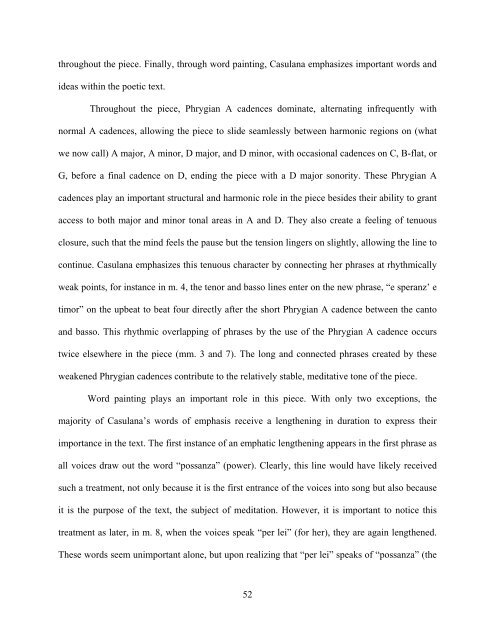Download - D-Scholarship@Pitt - University of Pittsburgh
Download - D-Scholarship@Pitt - University of Pittsburgh
Download - D-Scholarship@Pitt - University of Pittsburgh
You also want an ePaper? Increase the reach of your titles
YUMPU automatically turns print PDFs into web optimized ePapers that Google loves.
throughout the piece. Finally, through word painting, Casulana emphasizes important words and<br />
ideas within the poetic text.<br />
Throughout the piece, Phrygian A cadences dominate, alternating infrequently with<br />
normal A cadences, allowing the piece to slide seamlessly between harmonic regions on (what<br />
we now call) A major, A minor, D major, and D minor, with occasional cadences on C, B-flat, or<br />
G, before a final cadence on D, ending the piece with a D major sonority. These Phrygian A<br />
cadences play an important structural and harmonic role in the piece besides their ability to grant<br />
access to both major and minor tonal areas in A and D. They also create a feeling <strong>of</strong> tenuous<br />
closure, such that the mind feels the pause but the tension lingers on slightly, allowing the line to<br />
continue. Casulana emphasizes this tenuous character by connecting her phrases at rhythmically<br />
weak points, for instance in m. 4, the tenor and basso lines enter on the new phrase, “e speranz’ e<br />
timor” on the upbeat to beat four directly after the short Phrygian A cadence between the canto<br />
and basso. This rhythmic overlapping <strong>of</strong> phrases by the use <strong>of</strong> the Phrygian A cadence occurs<br />
twice elsewhere in the piece (mm. 3 and 7). The long and connected phrases created by these<br />
weakened Phrygian cadences contribute to the relatively stable, meditative tone <strong>of</strong> the piece.<br />
Word painting plays an important role in this piece. With only two exceptions, the<br />
majority <strong>of</strong> Casulana’s words <strong>of</strong> emphasis receive a lengthening in duration to express their<br />
importance in the text. The first instance <strong>of</strong> an emphatic lengthening appears in the first phrase as<br />
all voices draw out the word “possanza” (power). Clearly, this line would have likely received<br />
such a treatment, not only because it is the first entrance <strong>of</strong> the voices into song but also because<br />
it is the purpose <strong>of</strong> the text, the subject <strong>of</strong> meditation. However, it is important to notice this<br />
treatment as later, in m. 8, when the voices speak “per lei” (for her), they are again lengthened.<br />
These words seem unimportant alone, but upon realizing that “per lei” speaks <strong>of</strong> “possanza” (the<br />
52















